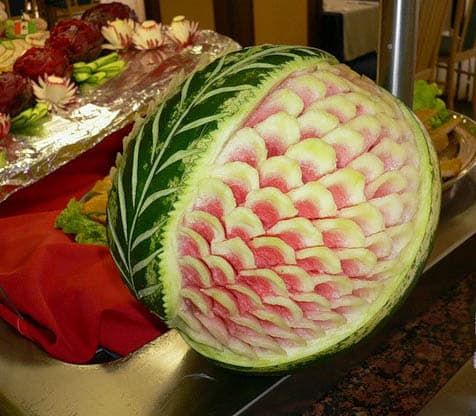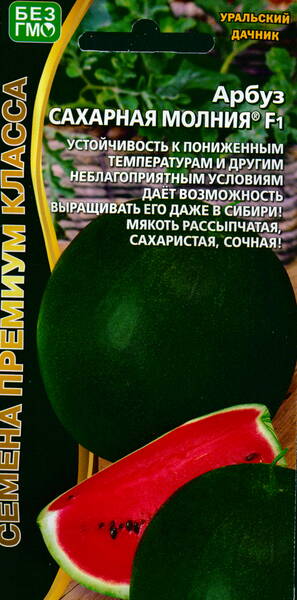A magnificent ultra-early hybrid that ripens easily in central Russia. The plant has short vines, with the main stem reaching no more than 1.8 m.
The leaf is small, deeply dissected, with narrow lobes. The fruit is spherical, black-green, with a hidden pattern, weighing 1.7-2.3 kg. The bark is very thin.
The scarlet “honey” pulp is tender, sugary, juicy, very sweet and aromatic.
The value of the hybrid: resistance to low spring temperatures, early and uniform yield, unpretentiousness of cultivation.
Agricultural technology.
Sow seedlings in early May. Plant outdoors in late May to early June, when the seeds have 3-4 true leaves. Planting pattern: 100x100 cm.
In southern regions, they can be grown by direct sowing in the ground in April–May. When grown under plastic covers, plants are trained into a single stem (all side shoots are removed up to a height of 50 cm, and subsequent shoots are pinched above the first to third leaf) and tied to a trellis.
For good growth and abundant fruiting, plants require timely watering, regular weeding and fertilizing with mineral fertilizers.

* Melon and watermelon are close relatives of familiar garden crops: cucumbers, zucchini, and pattypan squash. They 're practically uncle and auntie of the pumpkin family. And, of course, they're not poor relatives; they're more like generous southern guests! These large, berry-like pumpkins contain about 10% sugar!
Watermelon's sugars are primarily fructose, while cantaloupe's are sucrose. But the presence of sugars is undeniable—just try the juicy, scarlet flesh of a watermelon or the tender, melt-in-your-mouth melon!
And what about acids? Don't be surprised, they're present too. Valuable organic acids—citric, malic, and succinic—are found in both watermelon and cantaloupe.
Watermelon also contains niacin (an essential vitamin P), carotene, pectin, and fiber. It is also high in vitamin B9 and contains thiamine (B1) and riboflavin (B2).
Melon is also rich in ascorbic acid (vitamin C, three times more than watermelon), as well as a specific substance, inositol, which prevents hair loss and the accumulation of fat and cholesterol in the liver. Melon is also rich in iron (twice as much as chicken!), making it very beneficial for anemia.
Watermelons and melons contain mineral salts of calcium, magnesium, sodium, sulfur, phosphorus, copper, cobalt, and others, which, although in small doses, are essential for normal human functioning. Proteins, also present in small amounts in fruits, are represented by essential amino acids.
So, melon and watermelon are not just sweet water, but a storehouse of useful substances!
How delightful it is to enjoy juicy and sweet watermelons and melons, even if they're not as large as those in the south! Given the right conditions, these crops can even be grown in Siberia!
Let's get acquainted with some of the peculiarities of northern melon growing. Here are some rules.
Choosing the Right Varieties . Melons and watermelons are heat-loving crops. Varieties that can grow in harsh conditions without any cover have not yet been developed, and even if they exist, they haven't yet become widespread. Therefore, try to choose early-ripening varieties that are relatively tolerant of low temperatures. We'll recommend some of them below.
Seed preparation . Well-known pre-sowing preparation techniques, such as warming, germination, nutrient enrichment, hardening, and bubbling, are very effective and promote rapid germination of watermelon and melon seeds, increased plant resistance to adverse conditions, and increased yield.
Seedling cultivation. This method allows watermelons and melons to ripen 10-20 days earlier than when sown directly in a greenhouse. Seedlings are grown in the same way as cucumber seedlings, in pots or peat-humus cubes for a month. Hardening off the plants is done a week before planting.
Planting in warm beds . Beds enriched with fresh organic matter provide additional warmth to the root system of these plants, which is even more sensitive to low temperatures than the above-ground part.
Mulching plantings with peat and humus not only prevents soil crust formation but also improves temperature control. Black spunbond is an excellent alternative to mulch. Covering warm beds with it will increase the temperature in the root zone by a few degrees due to improved surface heating by the sun.
Temporary film cover . Plants are kept in a regular greenhouse made of a frame and film (like those used for growing cucumbers) until the onset of stable warm weather. Then, the film is removed, allowing watermelons and melons to grow outdoors, as they require direct sunlight. In unfavorable weather, the cover can be left in place for the entire growing season.
Using new materials . Combining traditional film with modern spunbond covering material produces excellent results. We've already mentioned how to use black spunbond, while white spunbond (choose the thickness depending on your climate) is used for additional insulation of plantings in cold weather.
When growing indoors, remember that watermelon and melon require artificial pollination.












